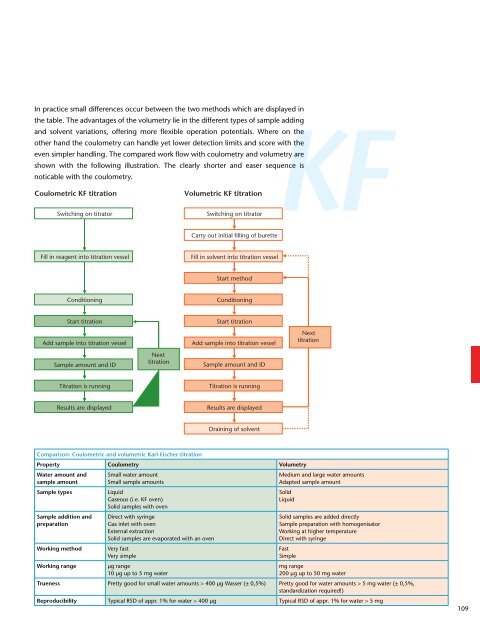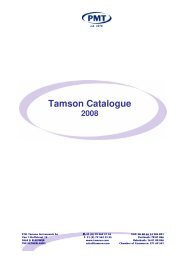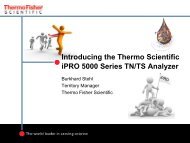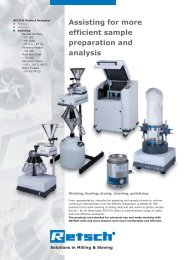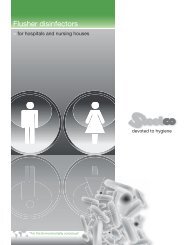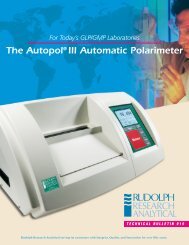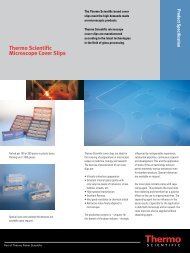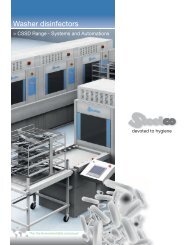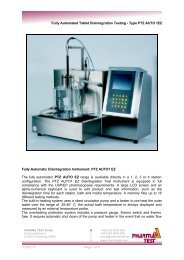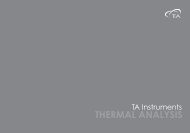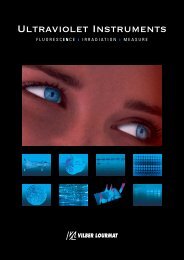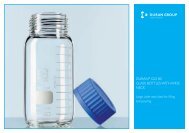Laboratory Products
Laboratory Products
Laboratory Products
Create successful ePaper yourself
Turn your PDF publications into a flip-book with our unique Google optimized e-Paper software.
In practice small differences occur between the two methods which are displayed in<br />
KF<br />
the table. The advantages of the volumetry lie in the different types of sample adding<br />
and solvent variations, offering more flexible operation potentials. Where on the<br />
other hand the coulometry can handle yet lower detection limits and score with the<br />
even simpler handling. The compared work flow with coulometry and volumetry are<br />
shown with the following illustration. The clearly shorter and easer sequence is<br />
noticable with the coulometry.<br />
Coulometric KF titration<br />
Switching on titrator<br />
Volumetric KF titration<br />
Switching on titrator<br />
Carry out initial filling of burette<br />
Fill in reagent into titration vessel<br />
Fill in solvent into titration vessel<br />
Start method<br />
Conditioning<br />
Conditioning<br />
Start titration<br />
Add sample into titration vessel<br />
Sample amount and ID<br />
Next<br />
titration<br />
Start titration<br />
Add sample into titration vessel<br />
Sample amount and ID<br />
Next<br />
titration<br />
Titration is running<br />
Titration is running<br />
Results are displayed<br />
Results are displayed<br />
Draining of solvent<br />
Comparison: Coulometric and volumetric Karl-Fischer-titration<br />
Property Coulometry Volumetry<br />
Water amount and<br />
sample amount<br />
Sample types<br />
Sample addition and<br />
preparation<br />
Working method<br />
Working range<br />
Small water amount<br />
Small sample amounts<br />
Liquid<br />
Gaseous (i.e. KF oven)<br />
Solid samples with oven<br />
Direct with syringe<br />
Gas inlet with oven<br />
External extraction<br />
Solid samples are evaporated with an oven<br />
Very fast<br />
Very simple<br />
μg range<br />
10 μg up to 5 mg water<br />
Medium and large water amounts<br />
Adapted sample amount<br />
Solid<br />
Liquid<br />
Solid samples are added directly<br />
Sample preparation with homogenisator<br />
Working at higher temperature<br />
Direct with syringe<br />
Fast<br />
Simple<br />
mg range<br />
200 μg up to 50 mg water<br />
Trueness Pretty good for small water amounts > 400 μg Wasser (± 0,5%) Pretty good for water amounts > 5 mg water (± 0,5%,<br />
standardization required!)<br />
Reproducibility Typical RSD of appr. 1% for water > 400 μg Typical RSD of appr. 1% for water > 5 mg<br />
109


